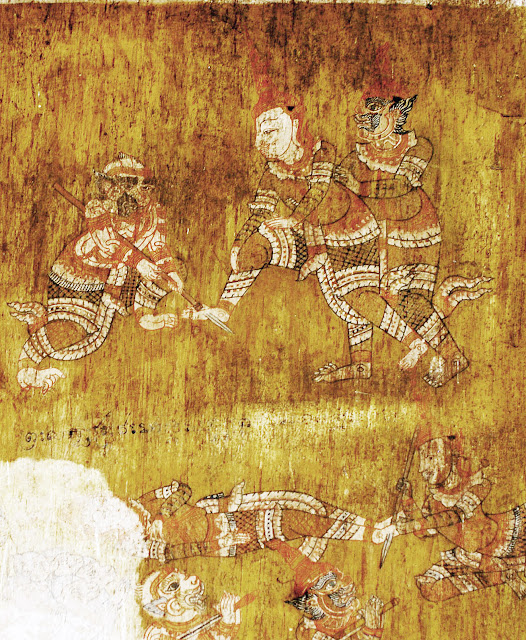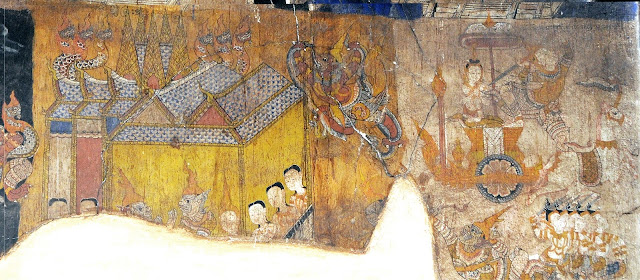The murals of Wat
Reach Bo of Siem Reap (Cambodia)
Vittorio Roveda
(Copyright text and pictures)
Due to the size and complexity of Wat Bo murals I had to separate my
presentation in two parts
Part 1 – Introduction and murals of the West and North walls.
Part 2 – Murals of East and South walls, conclusion and bibliography
PART 2
We have
seen in part 1 the cosmogonical part of the west wall, and on the North w all
the adventures of Ravana’s youth. The Birth of Rama, Lakshmana and their
brothers; (and of middle register (N.wall).
It was only on the top east wall that the
story of Seta starts, followed by the marriage with Rama, and Rama exile. To
the adventure in the forest, follows Ravana kidnapping Seta, then the efforts
of Rama and Lakshmana to find her. With the adventures of Ravana in Lanka end what
I have distinguished of part 1 .Now I will start Part 2q with the main events
to liberate Seta, the conquering of Lanka, the terrible injuries of Lakshmana
who finally manages to kill Indrajit, and ultimately the death of Ravana, with
whixh wends the Ramayana and the mural paintings of Wat Bo.
Because a very
complicated order of reading that characterize the decoding of Wat Bo, we have
to start from
East wall, upper register
This register must to be read from
left to right.
Fig.1.E - The long panel on the upper register of the
east wall announces indirectly the birth of Sita, insofar we see Ravana
consulting his brother Vibhisana on the meaning of the first words uttered by
the just-born Sita, “Ruin to Rap”
(left). Seated behind Ravana is Queen Mandodari, in a posture of lament. They
decided to get rid of Sita; the baby girl was placed into a chest and a servant
that threw itt into the waters (sea
or river?). Immediately, four devatas, headed by Mani Mekkhala, protected and carried the chest
to the shore, where it was discovered by Janaka, a king that had retired to a
hermit’s life (right). In the Reamker, this rescue is called royal ploughing ceremony (Jacobs, 1.5-10).
Figf.2.S.
- Janaka had the chest with Sita transported to his hermitage, where he is seen
holding the baby in his arms (right). As narrated in the texts, the baby was
fed with the milk springing from Janaka fingers; he also had a hammock ready
for the infant. However, Janaka could not keep the infant with him. So, he put
Sita into a golden chest to be buried under a tree by his assistant (right);
from the foliage of a tree, two devatas
are watching because they have become the baby’s guardians.
Fig.3.E.-
The narrative goes back to Ayuthaya, where Dasaratha is in his palace is bent
forward towards his four sons, already grown up, but still with the topknot of
children.
Fig.4.E.
-In the next panoramic view, they are shown demonstrating their ability in the
use of bow and arrow, with Rama shooting an arrow towards what appears to be
two maidens, one of which is depicted as a hunchback, although this is likely the same maiden twice (left).
In the next panel, the four brothers are shown as students, with pointed hats and
later kneeling in front of their four teachers (right)
Fig.5.S.
-When the ruler of Kaiyaket, father of Kaiyakesi learned he was the grandfather
of one of these princes, he sent a message to Dasaratha asking that Bharata come to live at Kaiyaket. Bharata did not
want to leave his father and brothers, but his father could not refuse the
request of Kaiyaket so he said Satrughna could accompany him. On the panel, we
see a chariot carrying Bharata and his brother Satrughna going to Kaiyaket escorted
by soldiers wearing Western hats, but carrying the typical pheak lance with curved cutting blade (bottom left). When they
reached the royal palace, they greet the king and queen (right).
The end the upper register of the
east wall.
East wall, middle register
This register must be read from right to left.
Fig.1 E.- The left part of the picture shows Rama giving order to Angada to protect his camp. The right picture shows , Ravana took the
disguise of an ascetic, depicted sitting near a building amongst rocks, in
order to deceive Rama. Rama, with Laksmana, Vibhishana, Sugriva and Hanuman, are
shown kneeling in front of the presumed teacher/ascetic. Ravana said that Sita
was the wife of Ravana, happier with him than she could be with Rama. Rama
replied that Sita was Lakshmi, faithful to her husband no matter what happened.
Ravana then warned Rama that Vibhishana was the brother of a demon and that he
will betray him; then he flew away. Note:
Rama and Laksmana sit with their hands held in a position of respect, but
Vibhisana is shown with his hands as if in agitation, and the monkeys hold
their hands at their sides.
Fig.2.E - Rama decided to send Angada to Lanka with a message for Ravana
asking him to free Sita. The decision-making meeting takes place under a large,
yellowish canopy in Rama’s camp, showing Angada taking off in the sky at the
top (damaged by water infiltration).
Fig.3.E. - Angada met Ravana, he raised himself to the same height as Ravana by coiling his long tail
to form a seat, as can be seen on the panel (center). At the end of their
discussion, Angada used his foot to remove Ravana’s crown, before flying into
the air, killing Ravana’s guards
(top left) and then he return to Rama.
Fig.4.E. - After this, to protect himself, Ravana ordered the opening of
the magic parasol of Lanka, bringing on total obscurity, to which Rama sends
Sugriva to destroy it. On the panel, we can see Sugriva wrecking the parasol,
creating panic and Ravana falling to the ground supporting two women.
Fig.5. E - .Humiliated by these defeats, Ravana, depicted sitting in a
pavilion of his palace, ordered his brother, Kumbhakarna, to attack Rama. On
the mural, Kumbhakarna is shown on a chariot pulled by reacheasei, with a royal umbrella, preceded by his army of yak leaving for the battlefront ( upper
part). Vibhisana asked Rama to spare Kumbhakarna from death since he was the
honest brother of Ravana, so Rama did.
Fig.6.E,(brown background) – Vibhisanais depicted when talking to
Kumbhakarna triyng to dissuade him from fighting on behalf of Ravana, to which
he replied that if Rama could solve a riddle, he would withdraw for the fight.
Presented with the riddle, Rama remained silent (he could not resolve it).
Fig.8.E. (blue background).-After this, Rama sent Sugriva to lead an army
to fight Kumbhakarna. Kumbhakarna tricked Sugriva by challenging him to a trial
of strength (uprooting and lifting large trees), and then, when Sugriva was
exhausted, captured him. The painted panel shows four scenes : (1) top right,
Sugriva uprooting a tree, having been tricked by Kumbhakarna to do so with the
intent to weaken him; (2) below right, the tired Sugriva holding the tree on
his shoulder; (3) bottom left, being attacked and grabbed by Kumbhakarna; (4)
top left, Hanuman, aided by Angada, attacking Kumbhakarna to free Sugriva.
East wall, lower register
This register must be read
from right to left.
Fig.1.E.
- The first mural of the lower register of the East wall shows Hanuman fighting
Kumbhakarna on water. The narrative of the Ramakien describes an episode
of Kumbhakarna making a dam with his body to block the water flowing to Rama’s army
camps (this episode is not depicted at Wat Bo). After Kumphakarna’s ploy had
been foiled by Hanuman, Ravana ordered Kumbhakarna to lead out an army. However,
in order to make sure to win the battle, he needed the magic lance he had
received from Brahma. In order to restore the weapon’s invincibility,
Kumbhakarna initiated a magic rite and sharpen his weapon. To stop this,
Vibhisana suggested that Hanuman transform into a decaying dog floating on the
river, and Angada into a crow noisily feeding on the dog’s suppurating bowels
(top part of panel). They floated past Kumbhakarna, irritating him with their
stench and filth, disrupting his ceremony and breaking his lance (lower part of
panel).
Fig.2.E.
- Only the upper part of the mural that follows is preserved, showing
Kumbhakarna facing a figure in a small palace (left), which, following the
reading of the Ramakien, would be Brahma, albeit with only one face and
two arms, handing him the wonder spear; immediately to the right, he is seen
holding the spear and grinding it on a stone to sharpen it, with Hanuman flying
down to disrupt this effort (right).
Fig.3.E.-
The panel that follows has Ravana in his palace at Lanka giving orders to Saeng
Athit, his nephew and holder of a magic glass-crystal with searing rays, to go
to war (Fig. 116 E).
Fig.4.E.
– Seang Athit left for the battlefield on his war chariot pulled by a reacheasei (Fig. 117 E).
Fig.5.E.
and 6.E. – On light-blue background, Rama called a meeting of his generals
(right) and gave directives to Laksmana and his soldiers before going to the
battle standing on his chariot.
Fig.8.E. - This panel is a bit difficult to interpret. Brahma was taking care of in heaven (see Ramakien of Rama I, Volume 3, 76-96) of a magic glass ball (crystal) that could emit rays able to blind and burn the enemy. Ravana had senrt Seang Athit to get it at all costs, but Angada was the first to reach Brahma, succeeding in obtaining the magic glass for himself to give to Rama.
To achieve this, Angada had to take the semblance of Chitraphairi, the assistant of the demon Saeng Athit. Angada is painted floating above a pavilion having taken thedemon’s form, to get the magic glass-crystal from Brahma. Curiously, the central panel shows Saeng Athit asking the ‘glasses’ to Angada, who refuses to give them (at the top of the white plaster part).
Accordingly, we can assume that the ‘waen kaeo’ in the Ramakien was translated into ‘glasses, or ‘spectacles’ in the Khmer narrative. Therefore, the depiction of spectacles on the mural could resulta) from a joke by the painters painting glasses (spectacles) instead of a glass-crystal; b) a mistake in the reading by the painters since ‘crystal glass/globe’ (the ‘waen kaeo’ in the Ramakien), could mean either glasses or crystal in the Khmer language; or c) the fact that the painters followed the versions of Okna Veang Tiounn. The French term “lunettes” is also mentioned in the narrative of Mi Chak dealing with the death of Adity (Bizot 1997:102).
Fig.9.E. - On the next panel shows
the episode when Laksmana was hit in the foot by the magic spear of Kumbhakarna
(top right). Hanuman is shown in the effort of trying to extract the spear.
Laksmana faint, lying inert on the ground with Rama trying pulling on the spear
(bottom right).
The end of the
east wall narrative.


































































